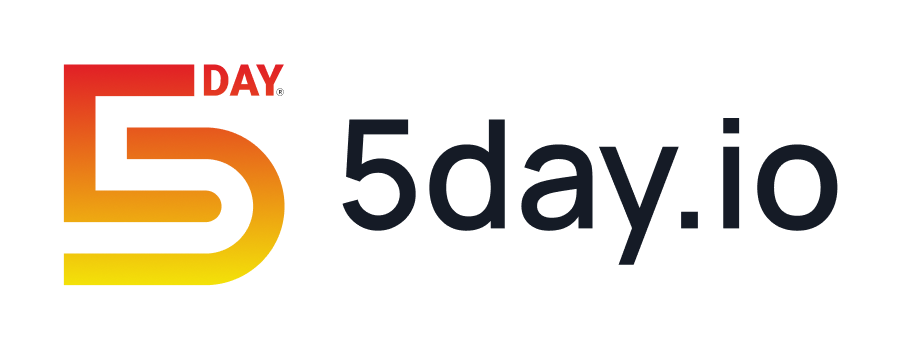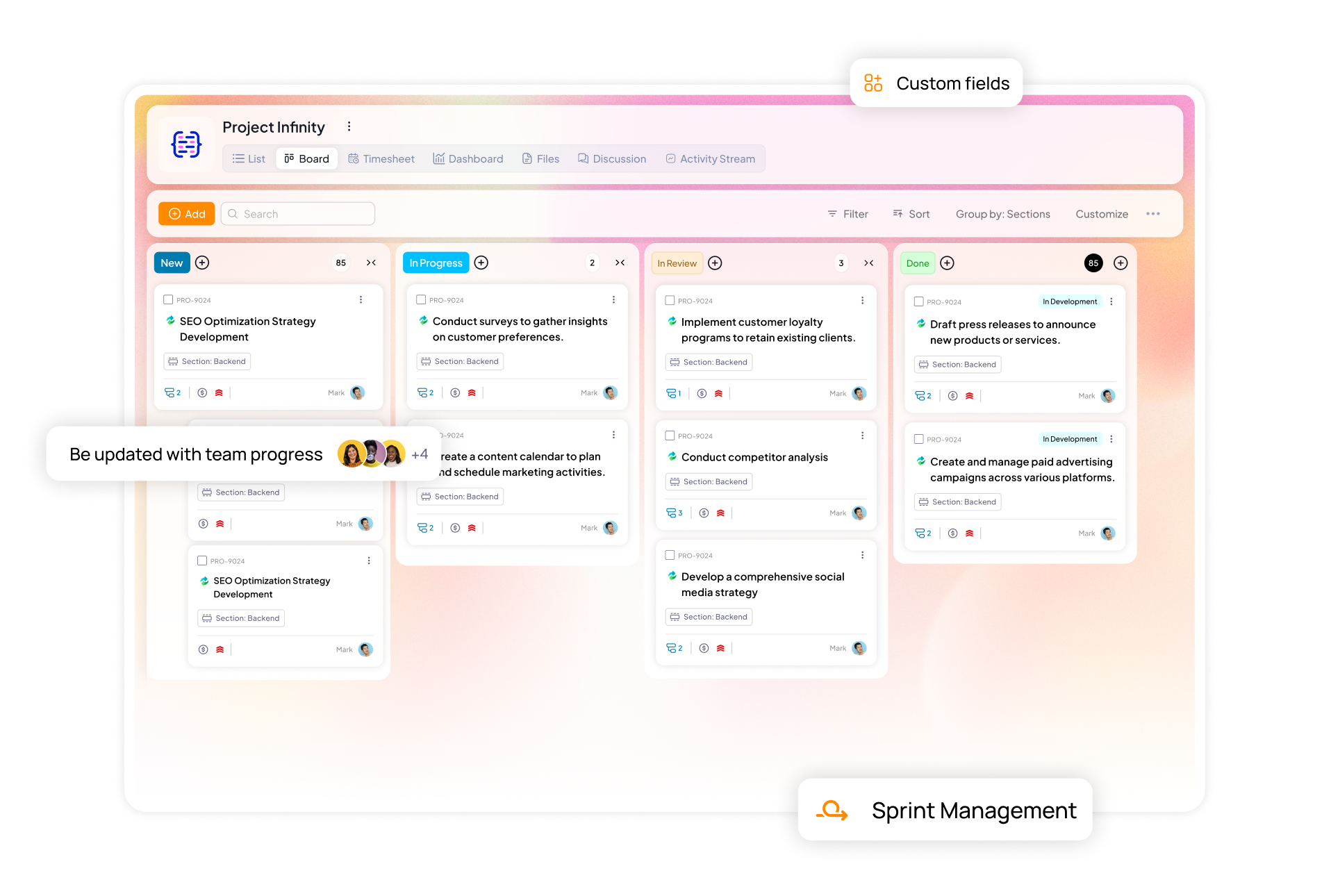In the agency world, perception is performance. And, nothing shapes perception like the quality of client reporting for marketing agencies. It translates work into impact and execution into strategic partnership.
Yet, many mid-sized marketing agencies still treat reporting as a month-end task instead of what it truly is: a live feedback loop that influences trust, retention, confidence, and renewal.
As client expectations evolve from passive recipients of updates to active stakeholders, your reporting model must evolve too.
This article unpacks the strategic importance of client reporting, the operational challenges agencies face with conventional tools, and how a modern project management platform like 5day.io can transform your delivery from reactive to relationship-driven.
Why is accurate client reporting so important?
The marketing agency landscape is highly competitive and agencies can thrive or falter based on the strength of client relationships.
A critical element of these relationships is client reporting. Far from a mere administrative task, effective client reporting is a strategic tool that showcases what value you generate for them and builds trust.
Some other reasons include:
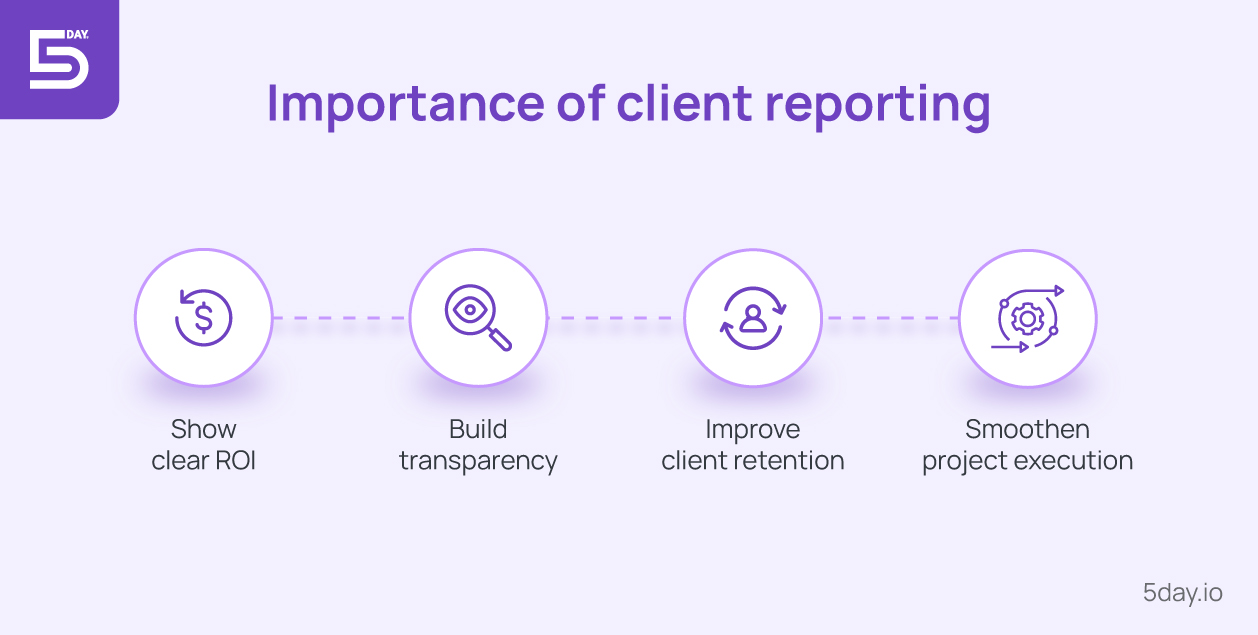
Demonstrating ROI
One of the foremost reasons you should prioritize client reporting is to prove the value and ROI of your campaigns.
As a mid-sized agency, you work with clients who need to justify their marketing spend—so showing concrete and actionable progress is paramount.
Your client reports should compile key metrics of project progress into a clear, easy-to-understand narrative of success. That way, you’re directly answering your client’s burning questions:
What kind of team did we invest in? Is the project moving toward success?
Instead of relying on gut feeling or assumptions, you can point to hard data in your reports to demonstrate exactly how your work is contributing to their business goals.
Pro tip: You can also take it a step further and map your project progress dashboard to the changes in their revenue. Use a marketing project management report with milestones mapped out and show it right next to the campaign ROI reports in your next meeting.
Maintaining transparency and alignment
Beyond the numbers, regular reporting is your best tool for building trust and transparency in your client relationships.
Your reports act as clear communication tools that help you build understanding and alignment with your clients.
By openly sharing the wins and the challenges, you show honesty and accountability. That kind of transparency assures your clients that nothing is being swept under the rug, and that they can rely on you as a trusted partner.
Impacting client retention and agency differentiation
Client retention is an agency’s lifeblood. And consistent, well-structured project reporting plays a big role in increasing trust and showing your clients that you genuinely care about their results.
Providing attentive service can be as simple as sharing transparent, frequent updates.
When you communicate openly in your reports, you reinforce your commitment to their success and that, in turn, reduces churn.
It also helps you stand out. In an industry where not every agency prioritizes communication, being the one that delivers clear, accessible progress reports can be your competitive edge.
Project execution without multiple redos
Effective progress reporting does not just benefit the client, but also helps your team stay within scope. Constant communication with the client ensures that you are working as per their expectations and can save your extra effort and overdos in the long term.
How is client reporting different from internal reporting? Different needs and purpose
Understanding the difference between internal and external reporting styles can improve client reporting drastically. Once you know what each stakeholder is looking for, report creation becomes the most powerful tool in your arsenal to win their trust. This section explores the major difference between creating reports for internal and external stakeholders.
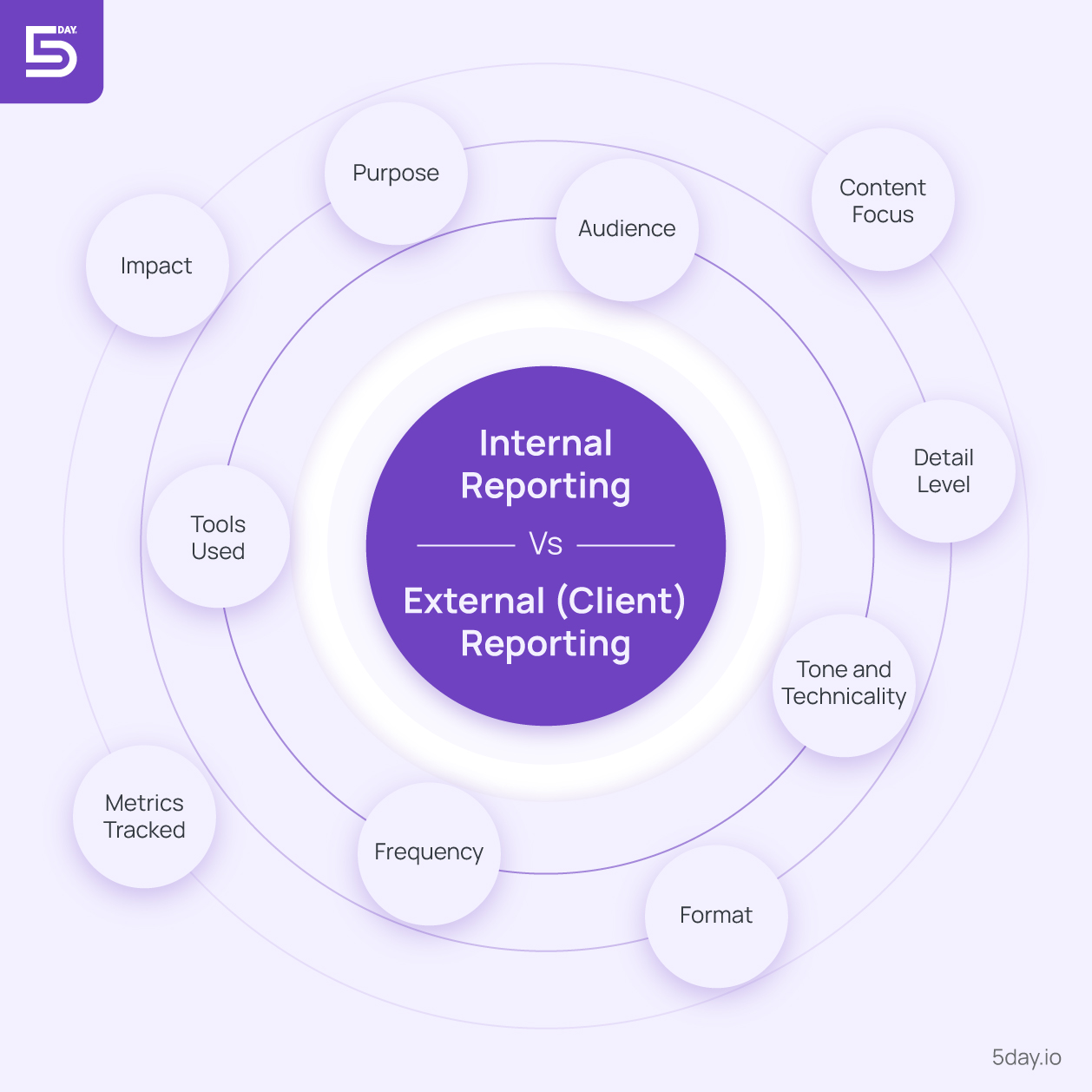
Aspect | Internal Reporting | External (Client) Reporting |
Purpose | Monitor team performance and resource utilization | Demonstrate value, communicate project progress, and justify investment |
Audience | Project managers, team leads, agency executives | Clients, sponsors, external stakeholders |
Content Focus | Task completion, timelines, hours logged, resource allocation, budget vs. actual | Project status in line with campaign results, KPIs, milestones achieved, and ROI |
Detail Level | High – includes granular, task-level, or team-specific data | Simplified and summarized – focused on what’s relevant to the client |
Tone and Technicality | Analytical, operational, uses internal jargon | Clear, jargon-free, client-friendly, with contextual explanations |
Format | Dashboards, internal tools, detailed spreadsheets or logs | Polished PDF reports, project management dashboards or client portal access |
Frequency | Daily/weekly (sprint reviews, standups, internal check-ins) | Weekly/monthly/quarterly (based on contract and client expectations) |
Metrics Tracked | Task status, deadlines, team productivity, project profitability | KPIs agreed upon (leads, traffic, conversions), budget spend, ROI |
Tools Used | Project management for marketing agencies, timesheet apps, task boards | Project management software (like 5day.io) with client-specific dashboards for billable time tracking and project progress dashboards |
Impact | Keeps execution on track, supports team decisions, resource planning | Builds client trust, improves satisfaction, boosts retention and upsell potential |
Common client reporting challenges faced by marketing agencies
Despite the availability of many tools, marketing agencies often encounter significant pain points in reporting process. Key challenges include:
Wasted efforts on manual data gathering
Many teams still spend hours pulling data from spreadsheets or disparate systems to prepare reports. This “status update drain” means account managers lose time each week gathering information and formatting client-ready reports.
Manual processes are also prone to mistakes. It’s easy to copy the wrong number or overlook a progress metric when aggregating by hand. This manual burden is unsustainable as agencies scale or handle more data.
Limited report customization
Agencies frequently lament that current tools or templates produce “generic reports that don’t meet client needs.” In practice, this forces teams to spend extra time tweaking or supplementing reports for each client.
Plus, manual reports are static and do not account for any real-time questions your clients might have during the meeting.
Let’s say they want to see the progress in the 4th stage of the campaign and what the prep is like. In manual reporting, you’d have to pull 6 different sheets in front of them including internal timeline doc.
But with a marketing agency project management software, you can simply show this data on your project dashboard within seconds.
Lack of insight in decision making
Today’s clients expect up-to-the-minute information, but many reporting processes deliver data with a lag.
If the PM tool can’t show live status or if reports are only compiled monthly, clients may feel in the dark in between updates. This creates what some call a “transparency paradox”: clients demand real-time visibility, yet agencies fear giving raw, unedited views of work in progress.
It also leads to a choice between constant manual updates or potentially oversharing internal details. The challenge is providing timely data without constant effort. Without real-time dashboards, even internal teams might make decisions on outdated information.
How to improve client reporting with project management software
Given the above needs and challenges, what would an ideal solution for project management in marketing offer? Based on industry insights, here are key recommendations for features and approaches on how a project management software could solve them.
Live dashboard for instant visibility
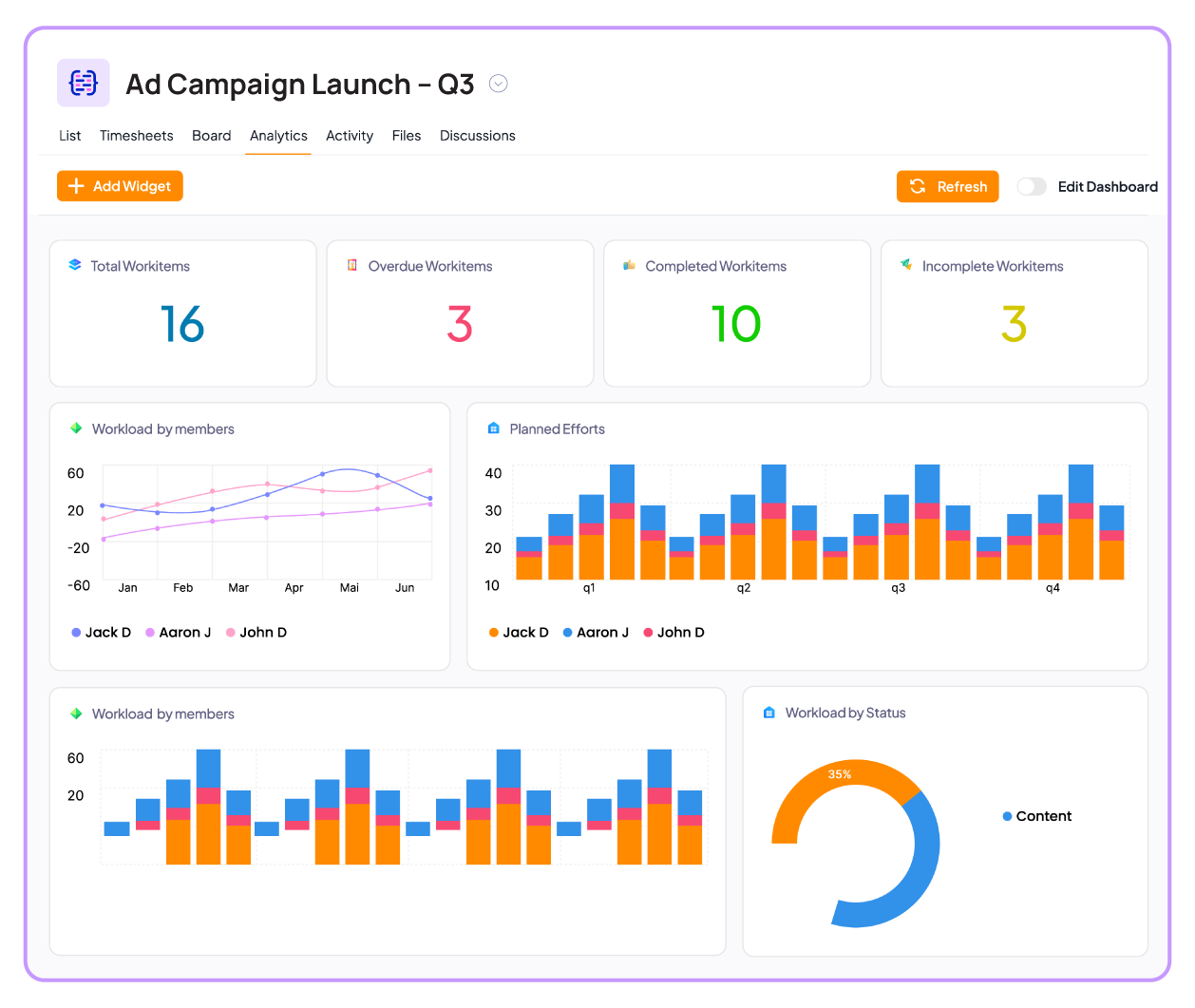
Set up custom dashboards that track progress at the project or campaign level. These dashboards give both your internal team and your clients a real-time view of deliverables. Show them completed, tasks in progress, and what’s coming up next—all without you having to build a report from scratch every week.
You can tailor dashboards by client, project, phase, or campaign, and choose which KPIs or tasks to showcase. For example:
- Internally, monitor blog production velocity and backlog status.
- Externally, share a clean view showing phase completion (e.g., “Keyword Research – 100%,” “Content Drafting – 60%”) without exposing behind-the-scenes details.
This eliminates guesswork and ensures project visibility is no longer tied to manual status updates.
Automation to reduce manual effort
With workflow automation, you can drastically cut down on time. Set up automated client-ready reports that get triggered based on key phases like end-of-month wrap-ups or campaign phase completions.
For example:
- Automatically notify clients via email when a new milestone is completed.
- Schedule weekly digests that summarize completed tasks and upcoming deliverables.
- Automatically update progress in shared dashboards as tasks move along your Kanban or sprint boards.
This automation frees your team to focus on insights and strategy rather than grunt work.
Client visibility with controlled permissions
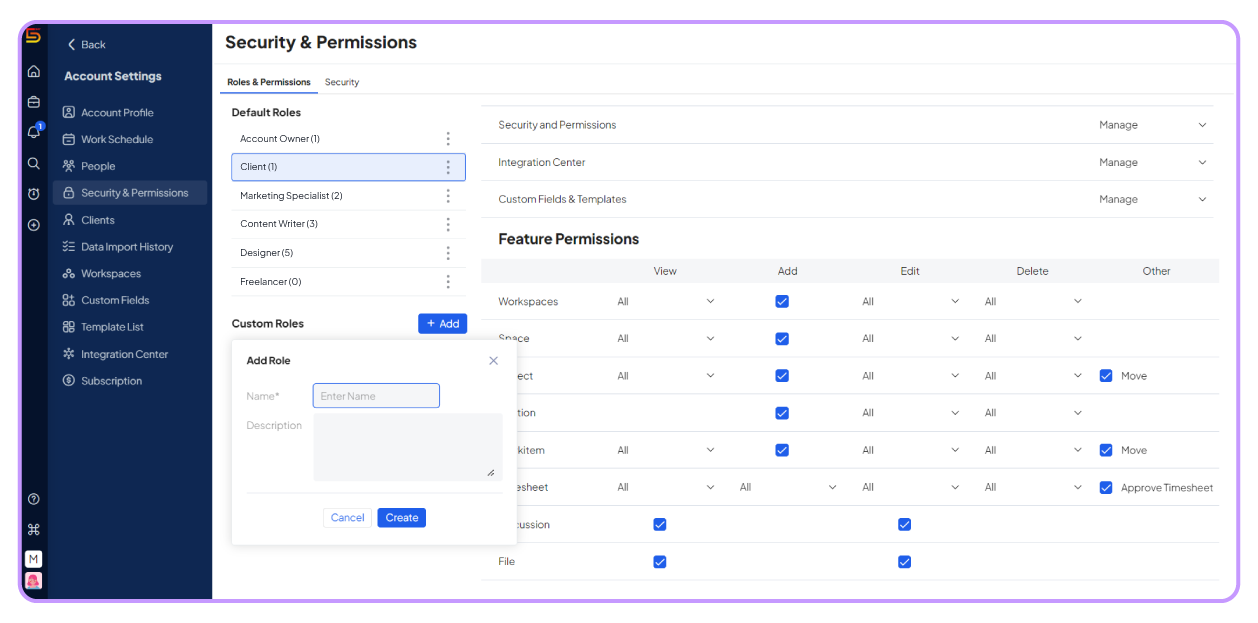
Create client-specific user roles and permissions, so you can confidently share progress without overexposing your internal operations.
Here’s how it helps:
- Set up limited-access views that only show what you want the client to see (e.g., project status, submitted deliverables, reports).
- Restrict access to internal discussions and time logs that are not meant for external eyes.
- Use shareable dashboard links or onboard clients into their own secure portal.
The result? Transparent collaboration without oversharing. Build trust while still protecting your team’s workflow.
Time tracking and billable work reports
![]()
Integrate time tracking and billable hour reporting to log time per task. Generate clear reports that show where your team’s energy went and how it mapped to deliverables.
Benefits include:
- Internally, understand how much time your team spends on high-effort vs. high-impact activities.
- Externally, generate detailed reports that show the client how their investment was allocated—e.g., “12 hours on ad campaign A/B testing, 8 hours on content creation, 3 hours on analytics review.”
- Set and track time per project or client, enabling proactive overtime tracking.
This makes it easier to justify time-based billing or retainer value, and eliminates ambiguity around “where the hours went.”
How can 5day.io help marketing agencies manage client projects: Different use cases
Campaign management
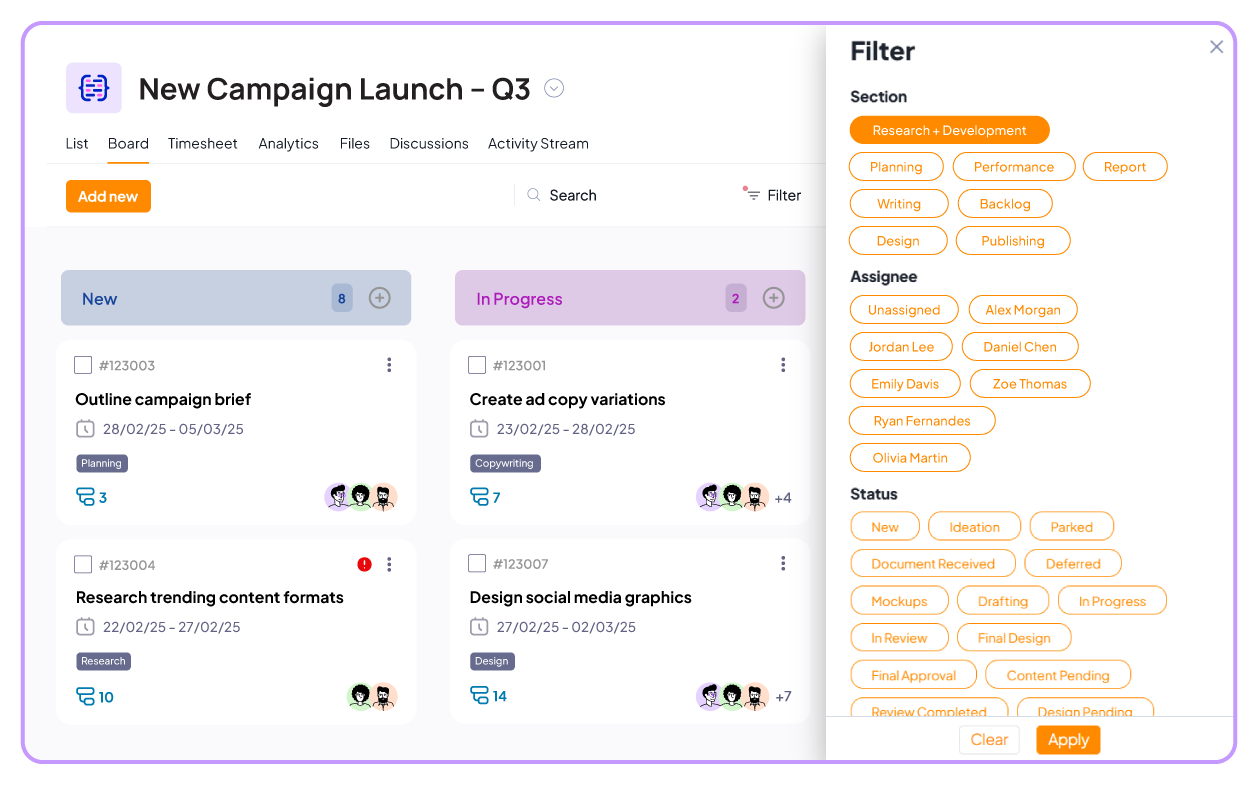
Managing multi-channel campaigns can get messy fast, especially when teams juggle briefs, deadlines, and client approvals across different tools.
With 5day.io, you get a centralized hub to plan, execute, and track every moving piece of your campaign roadmap.
From kickoff to wrap-up, your team stays aligned with phase based task division, progress and priority tracking, and quick, contextual feedback from clients.
This means fewer missed steps and campaigns that hit harder and land on time.
Content marketing

Keeping content workflows organized is critical. 5day.io helps your team map out an editorial calendar that connects ideation, production, approvals, and publishing in one clean flow.
Assign writers, set deadlines, attach briefs, and track the status at a glance. Instead of chasing content across email threads or spreadsheets, your team gets to focus on quality and your clients get consistent, measurable output.
Social media marketing
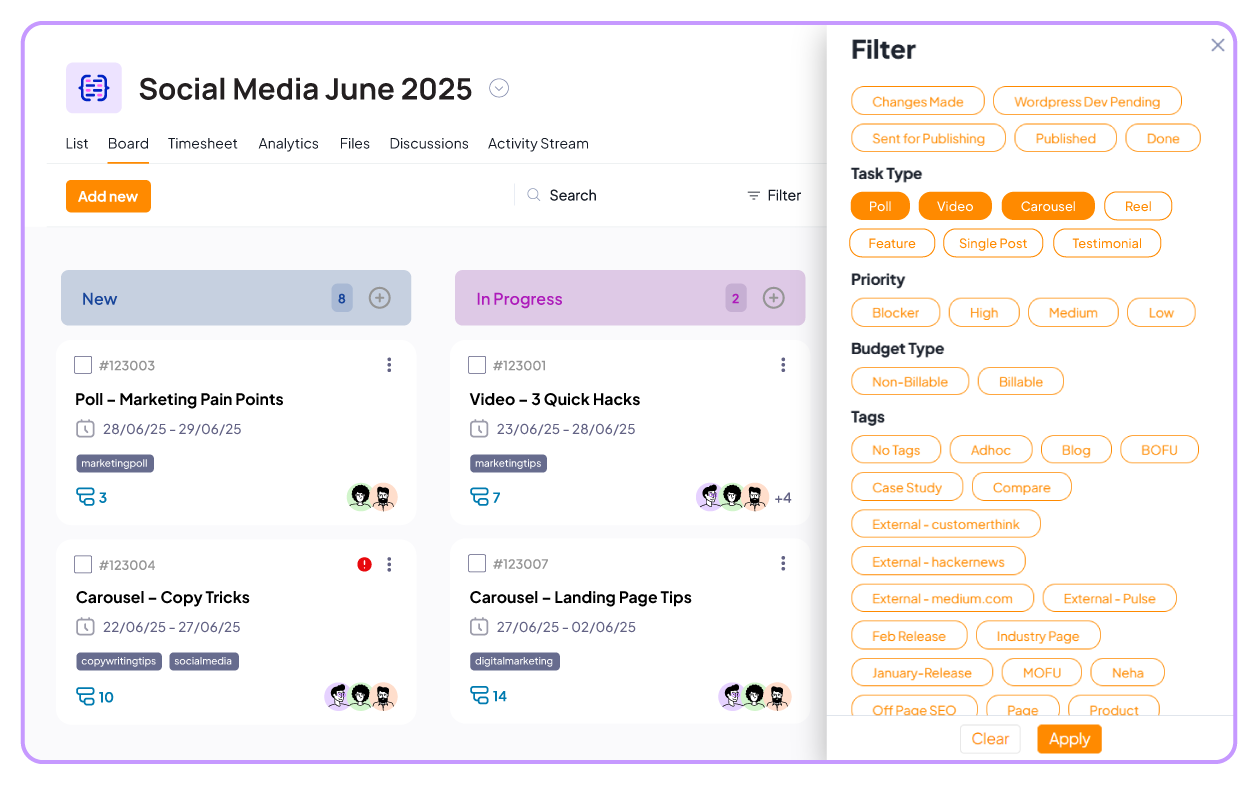
Social content runs on rhythm but repetitive tasks like scheduling posts or reporting performance can steal focus.
With 5day.io, you can automate and template recurring tasks, assign roles across design and copy, and keep platform-specific calendars clearly laid out. That means less firefighting and more time creating campaigns that spark engagement.
Plus, internal discussions and feedback stay threaded to each task, so nothing slips through the cracks.
Why choose 5day.io for client reporting and marketing agency project management
As a mid-sized marketing agency, your reputation hinges on how well you execute and how clearly you communicate results.
Handling campaign tasks, client expectations, team bandwidth, and performance metrics shouldn’t require five different tools and a weekly scramble. That’s where 5day.io stands out.
Unlike bloated PM platforms that overcomplicate the process or spreadsheets that leave too much room for error, 5day.io is designed to bring control to your workflow. With features like real-time dashboards, granular client permissions, collaboration, and integrated time tracking, you elevate your entire client experience.
The result? Happier clients, more efficient teams, and a smarter way to scale your agency operations.
It’s time to stop reporting reactively and start managing proactively. Improve client reporting with 5day.io and see how simplicity drives results.
Start your free trial today and give your agency the edge it deserves.
